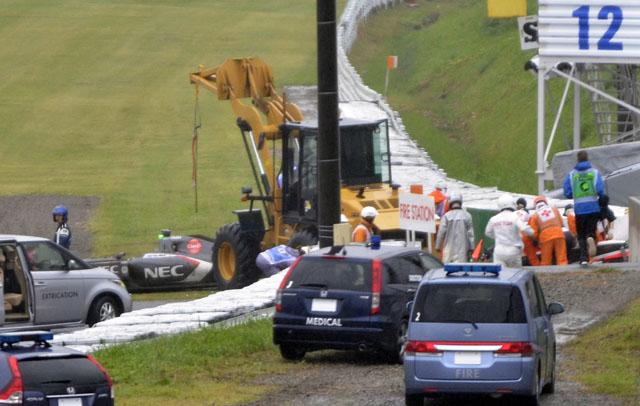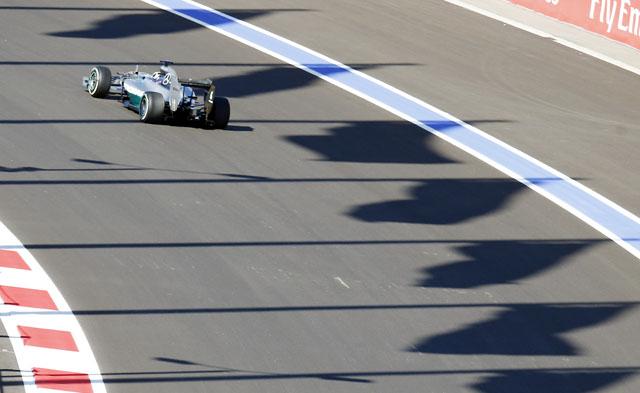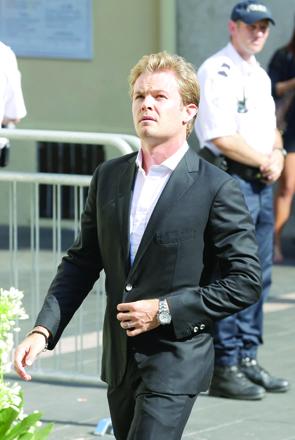You are here
Formula One safety back in the spotlight
By Reuters - Oct 07,2014 - Last updated at Oct 07,2014

LONDON — Formula One fans are used to seeing drivers walk away from terrifying accidents but sometimes, in a sport that will always be dangerous however much is done to try and reduce the risks, a hole appears in the safety net.
The crash that left French Formula One driver Jules Bianchi in a critical condition with severe head injures was down to bad luck rather than poor judgement by Japanese Grand Prix race officials, a track spokesman said on Tuesday.
The 25-year-old Marussia driver suffered the life-threatening injury on Sunday when he aquaplaned off a wet track and slammed into the back of a recovery tractor that had been deployed to remove Adrian Sutil’s crashed Sauber.
“Officials raised ‘double yellow flags’ after the accident by Sutil, which means drivers had to slow down to the speed that they can immediately stop, but unfortunately Bianchi’s car aquaplaned right at the time and ran into the accident site, which was bad luck,” Suzuka Circuit spokesman Masamichi Miyazaki said.
“Admittedly, rain was coming and the road was wet, but not heavy enough to halt the race, and I believe the race officials made the same judgement.”
The sport’s governing International Automobile Federation (FIA) said that president Jean Todt has asked FIA race director Charlie Whiting to carry out a detailed report into the precise circumstances of the accident.
The crash brought a premature end to Sunday’s race, with winner Lewis Hamilton and the rest of the paddock turning their attention to the likeable Frenchman, a graduate of Ferrari’s young driver academy.
The Marussia team acknowledged a “huge outpouring of support and affection for Jules and the team at this very difficult time” on Monday and on Tuesday the FIA said he was in a “critical but stable condition” at the Mie Prefectural General Medical Centre in Yokkaichi.
Others have wondered whether the sport can continue as an open cockpit formula, leaving drivers’ heads so exposed to danger.
The use of lumbering recovery vehicles, of the kind that Bianchi crashed into, in exposed runoff areas may also have to be reviewed.
The sport is praying that Bianchi pulls through, as Brazilian Felipe Massa did in Hungary in 2009 when he was hit on the helmet by a bouncing spring shed from another car, and that remains the prime concern.
But when things go wrong there are issues that have to be addressed and the answers may not be easy.
Despite constant efforts to limit dangers, with Formula One now having gone 20 years since the last driver fatality during a race, the possibility of a freak accident or tragic combination of circumstances is ever-present.
Max Mosley, the former International Automobile Federation (FIA) president who was instrumental in pushing through safety improvements following the death of Ayrton Senna in 1994, felt what happened at Suzuka fell into that “freak” category.
“I can’t really fault any of the people involved. The marshals or the race director or any of those people. I think everything was done as it should have been,” he told Sky Sports News television.
“For anybody to get hurt in modern Formula One, several things have to go wrong at once — a little bit like the aviation industry,” he added.
Tractor danger
The FIA said in a statement on Sunday night at Suzuka that the marshals had displayed double waved yellow flags before the corner where Bianchi went off to warn drivers of an earlier incident involving Sauber’s Adrian Sutil.
Double waved yellows are a signal to a driver to slow right down and be prepared to stop.
Whether Bianchi saw those flags in the rain and poor visibility remains an open question, but the facts are that he lost control with the car crossing the runoff area and hitting the rear of the recovery vehicle as it was lifting the Sauber.
No television footage was shown of the impact, but photographs indicated the roll bar had been ripped off.
“After Senna and [Austrian Roland] Ratzenberger were killed in 1994 in one weekend, several other life-threatening incidents and another a fortnight later with [Austrian Karl] Wendlinger, we started a programme of systematic research on all aspects [of safety],” Mosley added.
“Crash helmets, driver protection in the car, rollover bars, fire precautions and so on. That is an ongoing thing.
“In this particular case, I don’t think any of those precautions would have helped because as I understand it, he went in under the tractor. And that’s what caused the danger.”
There has long been concern in Formula One about the use of such tractors and cranes while the race is still going on.
Automatic procedure
Seven times world champion Michael Schumacher, now coping with his own head injury after a skiing accident last year, was lucky to escape serious injury in 2003 when a recovery crane was deployed during a rain-hit Brazilian Grand Prix.
The German’s Ferrari skidded off at the same spot and almost crashed into it, fortunately hitting a tyre wall instead.
In Canada last year, a marshal died after being run over by a mobile crane while hurrying to remove Esteban Gutierrez’s crashed Sauber towards the end of the race in Montreal.”
The alternative to deploying such a vehicle would be to leave a crashed car in a potentially dangerous position, with accompanying risks, or bring out a safety car before the tractor is given the go-ahead.
“There’s pretty much an automatic procedure that as soon as a car goes off, that car becomes a danger to other cars. If another car going off at the same place hits it, the effects are unpredictable. So you want to remove the car as quickly as possible,” said Mosley.
The Briton also defended organisers from those who questioned why Bianchi was taken to hospital by road ambulance rather than in the medical helicopter.
“That’s a medical decision... when you have a head injury, sometimes it’s very dangerous to take somebody up in the air where the pressure drops and things then get worse,” he said.
“We always think that [American Mark] Donohue in 1975 died because he was taken to hospital in a helicopter and had a brain haemorrhage. The doctors will decide whether it is safe or not to take the driver in a helicopter,” he said.
Related Articles
French Formula One driver Jules Bianchi suffered a traumatic brain injury in his Japanese Grand Prix crash and remains in a critical but stable condition, his family said.
Formula One leader Lewis Hamilton was fastest in Saturday’s final practice for the inaugural Russian Grand Prix as Mercedes continued to dominate a weekend likely to seal the constructors’ championship.
The championship tussle between Lewis Hamilton and Nico Rosberg will take a back seat at the Hungarian Grand Prix this weekend, with Formula


















